most popular iran handicrafts
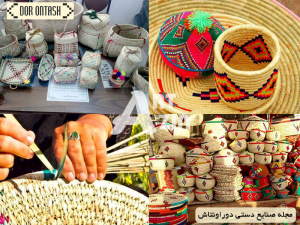
As a vast land, Iran offers thousands of most popular iran handicrafts and works of art that reflect the rich Iranian culture. In the historical works of Iran, signs of the art of architects, painters and engineers can be seen in tombs, mosques, palaces and historical buildings. Each of these works shows a part of the identity and culture of the people of their era with prominent signs from different historical periods.
As the native and traditional art of the people of our land, Iranian handicrafts play an effective role in strengthening the economic situation of different regions of the country.
Currently, Iran’s handicrafts are considered one of the top three poles of handicrafts in the world, and proper investment along with detailed planning in the production and introduction of these works at the global level can generate high income at the national level. Also, one of the pleasures of tourists traveling to Iran is persian handicrafts from different cities.
It is not easy to introduce all Iranian handicrafts in a short portfolio, but here you will study some of the most popular Iranian handicrafts that have a high reputation in the world.
Enamels | most popular iran handicrafts
Mina in the word means blue sky, but in the term it usually means a piece of metal or clay that is shaped into a dish, glazed, a slime painting is drawn on it, and then baked. Glaze is a combination of organic and inorganic materials such as copper oxide, cobalt and iron, which is used for strength, polish and beauty of enamel dishes.
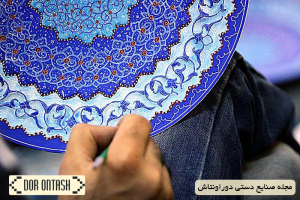
The art of enameling is the art of painting and decorating gold, copper and silver metals with a special enamel color that is baked and stabilized at high heat. It can also be said that enameling is an artistic combination of fire and earth and full of master enameller’s taste, with baked colors of mineral origin. With a history of about 5000 years, this art has been used by humans to beautify metal utensils and ornaments. The origin of the art of enameling is ancient Iran, and with the passage of time, due to the popularity and spread of this art, other countries were also encouraged to work in this field.most popular iran handicrafts
Tips for identifying original and high-quality enamel
First: The enamel infrastructure must be uniform and integrated and free of unnecessary and redundant parts
Second: The support surface of the container must be completely flat and uniform
Third: The enamel glaze must be free of any cracks, cuts, cracks, bubbles, peeling skin, holes or roughness.
Fourth: The concentration of the enamel glaze must be the same and uniform on all work surfaces and have the same diameter (no protrusions).
Fifth: The surface of the enamel should have sufficient brightness and be transparent, shiny and polished, which means that the above-mentioned materials have a good color and proper baking in the oven.
Sixth: The thickness of paint in enamel painting and decoration should be uniform, and the colors used in the border of the designs should not be merged.
Seventh: The motifs must have Iranian authenticity
Eighth: In coloring and writing, elegance in work and accuracy in execution should be taken into account
Ninth: The back of the dish or any enameled object must have a high-quality, scratch-free glaze
10th: Like any other product and artwork, the enamel work must have a code, name of the artist, date and place of production
carpet weaving | most popular iran handicrafts
Carpet weaving is one of the original and valuable arts that has a long history in Iran. This original art has an unbreakable link with the ancient culture of this border and landscape, and over the centuries it has been considered one of the most important achievements of Iranians and is currently considered a part of the life and culture of the Islamic Iranian society.
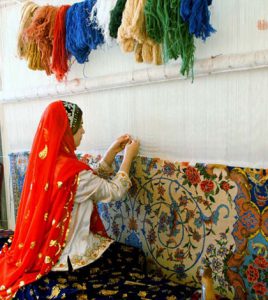
Undoubtedly, in addition to its economic dimensions, the carpet is a manifestation of the national art and cultural heritage of Iran, and its preservation and expansion is a national duty for the entire Iranian society. The link between historical works and original Iranian carpet designs and maps represents the cultural dimensions of this industry and expresses the innovation, creativity and the peak of the prosperity of the art of the villagers and underprivileged classes, who have created amazing effects over the centuries with minimal means.
It is interesting to know that the art of carpet weaving and setting up a carpet workshop is well received even in today’s modern society; To the extent that some native neighborhoods in the provinces look at these workshops as a good source of income.
Since the art of carpet weaving is welcomed by different sections of the society, in this specialized article we talk about carpet weaving and everything we need to know to start a carpet weaving workshop. In this colorful, complex and very attractive world, we will come across different expressions. In this article, we talk about all these things briefly. At the end of this discussion, you will understand that the art of carpet weaving and setting up a well-equipped workshop can help create jobs and be profitable.
miniature
Maybe you have come across the strange and wide term “miniature”. This word is a word that shows itself in a wide range of our lives, from miniature paintings to miniature antiques and even miniature clothes and handicrafts. But the main question is: What is this miniature? What exactly do we call a miniature and why?
What does the word miniature mean?
Before examining the concept of miniature, it is good to examine this word and its rejection in different languages, so that we can get a more precise concept of it.
The word “miniature” is derived from the Latin word “minimum natrural” and means “nature reduced”. This word entered the Persian language during the Qajar period and the impact of the Persian language on the French, and since that day, it has gradually become common among people of art and common people.
What is a thumbnail?
The meaning of miniature or painting is authentic Iranian painting, which Iranians learned the art of painting from eastern countries many years ago and they also adopted the art of painting from Iranians. In a certain period of history, drawing any painting that contained unrealistic elements was considered an insult to creation. Therefore, with the help of their imagination and inspiration from nature, Iranians turned to creating paintings, which became known as painting.
Due to the involvement of imagination in these works of art, exaggeration and exaggeration can be seen many times. One of the most obvious features of miniature painting is the non-use of mixed colors and perspective. But master Mahmoud Farshchian has used both mixed colors and perspective and anatomy in his works.
Weaving
Cashmere weaving
Cashmere fabric is a delicate and delicate fabric that is made of two rows of warp and weft yarn that is woven by hand in such a way that the weft on the back of the fabric is free and the weft density is high. It is made of fluff and wool or silk with original designs. And it is traditional in Iran.
Kashmiri or Iranian cashew
Some people may not accept this story and consider the birthplace of Termeh to be Central Asia and the highlands of Kashmir. About “Where is the birthplace of Termeh?” There is a difference of opinion, but Fatima Erfani, an expert in handicrafts, says:
“If we have an overview of handwoven and each of the other branches of Indian handicrafts, we will easily realize that Indians have used a Buddha statue, special Indian architecture or animals such as elephants, tigers and other symbols of India in terms of their religious status and living conditions, while In cashmere woven from Kashmir, the only design and pattern specific to Iran can be seen, such as the almond pattern, and this is a strong proof that the cashmere is Iranian.
Clay dishes | most popular iran handicrafts
Pottery is one of the most popular crafts in Iran among tourists and has a long history. In every region of Iran, due to the access to the element of soil, making pottery has been popular since the distant past. In different historical periods, people made pottery by mixing water and soil and making clay vessels, and over time, clay replaced ordinary soil. The most prominent historical pottery are jars and bowls found in ancient buildings.
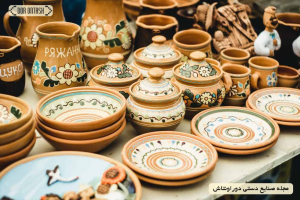
Pottery is divided into two categories: unglazed and glazed. In different cities of Iran, there are museums called Diyar Pottery Museum, where you can see all kinds of historical pottery. Hand pottery, wheel pottery and potting are among the subsets of pottery art.
Ancient jewelry | most popular iran handicrafts
Many signs of the manufacture and use of ornaments in different governments and periods can be seen among historical works. Iran’s traditional ornaments have beautiful and special patterns and today many of them are kept as antiques in museums all over the world. Materials such as gold, copper, silver and shiny stones are used to make these ornaments. Iran has been the owner of various stone and metal mines for a long time, and for this reason, in the cultural works left from the past, there are a large number of decorative items and ornaments that were made using precious stones and metals.
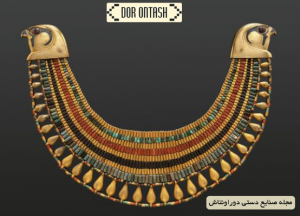
On the other hand, due to its ancient history and admirable civilization, Iran has always been a leader in innovation and social affairs. For this reason, paying attention to beauty and attractive objects is one of the characteristics of Iranian civilization, which has made ancient Iranian civilization known as one of the birthplaces of making jewelry.
The history of the use of ornaments in Iran
From two thousand years before Christ, Iranians made bracelets, necklaces, bindings and various other pieces using colored beads and metals such as copper, which could be used by men and women. In the past, jewelry was also used by men, but today women are the main audience of this industry.
Achaemenid period
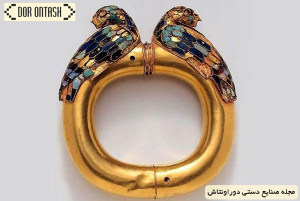
During the Achaemenid period, ornaments were made according to ancient and religious traditions and rituals. Many of these pieces have been discovered in the form of armbands, bracelets, plaques, rings, sunshades, etc., or their effects can be seen in the paintings and engravings left from that era. In this period, special attention was paid to precious stones. Also, during the Achaemenid period, Cyrus the Great minted a gold coin for the first time, which was recorded in history under the name Darik. Before this period, copper and silver coins were used to exchange value.
Parthian period
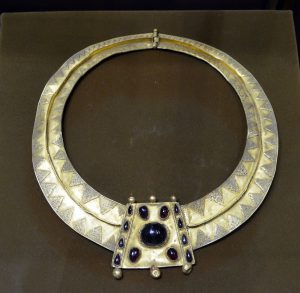
During this period, the designs became more magnificent and beautiful. Jewelry making was developed in the Parthian period and small objects became very important. Ornaments were also used to decorate the space, and the Parthians’ interest in shining led to the creation of pieces that still have a high shine.
Sassanian era
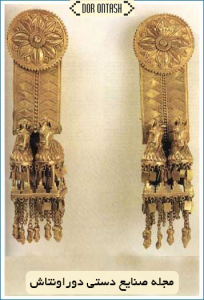
This period can be considered as the peak of the history of the use of ornaments in Iran before Islam. During the Sassanid period, various materials were added to the field of jewelry making, and gold, as the main part of jewelry and ornaments, gave a beautiful effect to the pieces made in this period. The great interest of the kings in using gold ornaments and combining gold with precious stones was another reason for the growth of the ancient Iranian jewelry industry during the Sasanian period.
After the conquest of Iran by Muslims, various arts were also influenced by Islam. In fact, in addition to the fusion of Iranian and Islamic art, the customs of Muslims and Arabs also played an important role in determining the path of the artists of this period. Many ornaments and jewels were made to praise and praise prominent religious people and concepts, and instead of seeing precious objects in palaces and royal houses, we see the use of precious metals and precious stones for enameling, embossing and painting the walls and surfaces of mosques. We were places of pilgrimage.
Until the arrival of Islam in Iran, the classical techniques of Eastern Rome came to the aid of artists to be used in the process of making ornaments, and after the spread of Islam in Iran, we witnessed a combination of Iranian tradition, western techniques and Islamic concepts in the creation of works of art and as a result We were ornaments.
Timurian period | most popular iran handicrafts
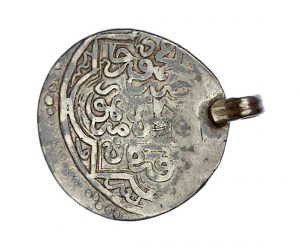
The kings of this period were very fond of ornaments, and the effects of this can be clearly seen in the buildings left from that period. In this period, women used ornaments for their hair. The Timurids made jewelry popular among ordinary people and considered as a decorative device for the general public.
Safavid period
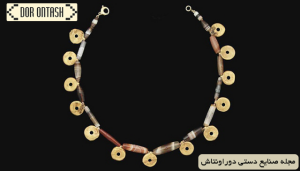
The surviving miniatures from the Safavid period show that this government attached great importance to ornaments and jewelry. The Safavid period is one of the magnificent periods of Iranian history in terms of architecture and culture, and ornaments underwent many changes in this period. This period was one of the last periods in which the works of Islamic and traditional concepts were still superior to modern and western techniques, and ornaments were also made according to religious customs. Perhaps this period can be considered as the end of the history of the use of ornaments in Iran in a traditional way. After the Safavid era, Western art played a large role in the design of various objects, including ornaments.
Qajar period | most popular iran handicrafts
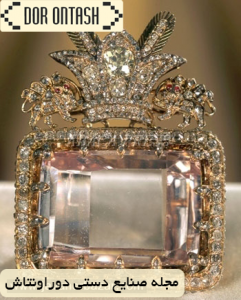
Unfortunately, during this period, Iranian culture and art underwent many changes, and the western style was supported by the Qajar kings. During the Qajar period, like many other capitals of the country, traditional and old ornaments were neglected. According to many, the word “fashion” entered the culture and language of Iranian society during this period, and after the kings and courtiers, people were also influenced by the beautiful appearance of western creations.
Crochet
Crocheting is one of the handicrafts of embroidery. In Iran, these works have been seen since 550 BC.
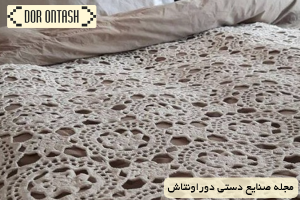
This beautiful art flourished during the Seljuk period, and the artists of Rasht, Isfahan and Mashhad have left beautiful handicrafts related to that era.
Crochet or Rashti embroidery is one of the most popular handicrafts in Iran and many women are interested in this beautiful handicraft.
Crocheting means sewing a pattern on fabric, using hooks and silk threads, and it is one of the beautiful needlework and Iranian handicrafts.
This beautiful handicraft is used to decorate the table, carpet, collar edge, cushion cover, lampshade cap, etc.
Navy embroidery
There is no referenceable writing about the history of the art of sermeh embroidery in ancient times, but what is certain is that the Iranians’ attention to the decoration of the collars of clothes and the decoration of military and court clothes and hats has forced them to produce this type of decorative thread (sermeh). . Sarma is a type of metal thread that used to be made of gold and silver or a percentage of gold and silver, and nowadays it is made of ordinary shiny metals, and it is used for stitches such as serma embroidery, sharfa embroidery, sun embroidery, armor embroidery and along with stitches such as ten one embroidery, Stone embroidery, sequin embroidery, beads and studded embroidery, cash and glabton embroidery, etc. are performed.
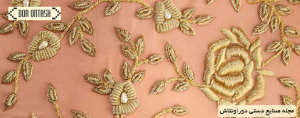
The popularization of silk embroidery is attributed to the Parthian period, the embroidered works in this period were exported to other parts of the world.
In the post-Islamic periods, navy blue was used to sew the curtains of God’s house and Quranic verses (embroidery).
The remaining works show that the flourishing of the art of silk embroidery was related to the Safavid period. In the following periods, silk embroidery underwent many changes until it reached the present era. The fabrics used can be: cashmere, velvet, mahout, He mentioned silk, taffeta, satin, satin and silk.
This sewing is used to decorate: exquisite curtains, tablecloths, bedspreads, cushions, rugs, rugs, janmaz, and Quran covers, as well as the cover of old chests, suzan-dan, hats, decorative panels, etc.
In the olden days, there are more motifs of embroidery: flowers and vases, flowers and hens on the border, mihrabi, bete jakeh (cypress, srouche almond, kharu ashti, two and three heads, mother and child, deer antlers and…) Salimi, Khatai, There were birds, hunting ground, tranji and special lines: Enigmatic, Mothani and Diwani.
Textile and weaving crafts
Traditional embroidery | most popular iran handicrafts
Embroidery means to sew a beautiful design and painting on the fabric with a special needle and thread. From the past to the present, there are designers who draw beautiful ideas and paintings on fabric, and then artists fill this design with different colors and finally it becomes a painting or a design on a mantle, scarf, etc. At first, the designs that were chosen for embroidery included all kinds of flowers or animals, but with the development and expansion of this art, it became different designs. Nowadays, we see the embroidery of paintings and modern designs on fabric.
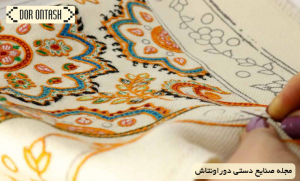
The art of making patterns on the surfaces of fabric with the help of needle, thread and hook is called needlework, thread embroidery, face embroidery or decorative stitches, which is one of the widest fields of handicrafts.
Iranian embroidery has more than 115 separate threads with 120 types of stitching, which have been created and continued since different times depending on the habits and traditions of many Iranian tribes. In the meantime, unfortunately, some of these stitches are completely obsolete and some are half-hearted.
Needlework, thread embroidery, or embroidery is one of the ancient ways of making clothes. In the west of Iran, pieces of needle-embroidered textiles with complex patterns have been found, the date of their manufacture reaches six thousand years before Christ.
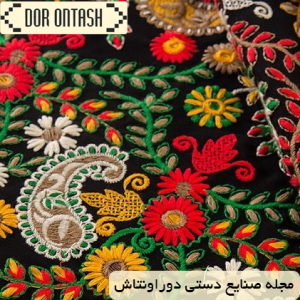
Apart from the decorative aspect and birth certificate, hand-stitched clothes are sometimes displayed on hats or clothes due to religious beliefs. Before Islam, apart from the decorative aspect, it was also used as a talisman.
In examining the remains of the Persepolis Palace and the tiles discovered in Susa, the clothes of nobles and courtiers and their guards are prominently and luxuriously decorated and can be seen.
According to Haru Dut, the wife of Khasyar Shah, she wove and sewed the clothes of the king and herself. From that period until now in different historical periods, including Safavid and Qajar, this art was very popular, but over time and depending on foreign fashions, the use of these arts decreased a lot. most popular iran handicrafts
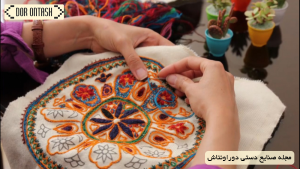
The discoveries obtained from the research of archaeologists in different parts of the world and historical periods show that even the roots of the main elements of today’s embroidery go back to Iran, which went to Italy and Spain through the countries of the Mediterranean Sea and later in the lands of has been taken into account.
This art went to Europe from Byzantium around the 4th century AD and found a specific European form. At the beginning of the 13th century, the crusaders went from the west to the east with their achievements and brought with them outstanding examples of oriental embroideries. At this time, another type of bread embroidery “Appleke” or piece embroidery appeared, which apparently originated in Iran, where family emblems were embroidered and placed on clothes.
One of the most famous embroidery methods was the Spanish style, which spread throughout Europe for a century. This method consisted of a black silk background on which golden threads were used.
wooden handicrafts
Using wood to make handicrafts and practical and decorative items has been common for a long time. Wooden handicrafts have had many fans since ancient times. Today, despite the variety of materials and decorations and various sculptures, wood still has a unique beauty and its handicrafts also have a special place. In this article, we would like to introduce the types of wooden handicrafts, finger joint handicrafts, the methods of making them, the tools and equipment needed to make them.
All kinds of wooden crafts
Wood is made and decorated in different ways such as: turning, cutting, cutting and fastening or a combination. According to the type of use of these methods and the type of wood construction, the art of traditional woodworking is also divided into different types.
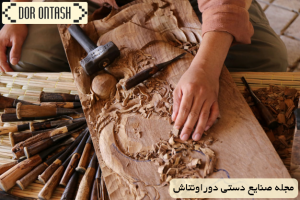
The types of these wooden crafts are:
- Woodcarving
- Lathe
- Lattice work
- Marquetry
- Chinese knot
- joinery
- Khatam Kari
- Inlaid water
- Maraq Khatam
- Wooden volumes
In the manufacture of wooden crafts, according to the type of application, it is made flat or volumetric. Different designs and patterns are used to decorate these handicrafts. Using the color, veins and natural texture of wood as one of the beautiful and decorative features of wood is of interest to the artist. Also, to decorate these handicrafts, studs and metal fittings are also used as arrays and decorations.
Stone crafts
“Stone” is one of the objects that has been of special importance to mankind since long ago due to its special characteristics; Because it does not burn, does not rot, does not rust and does not crumble easily. Therefore, humans use it in different ways; Whether in making agricultural and hunting tools, whether in building a house, whether in sculpting and home decorations, etc.
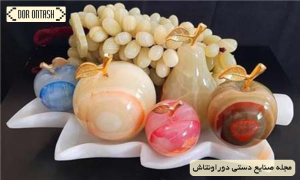
Many historical monuments have been left behind, such as the prominent carvings of Rostam in Firozabad, Fars, Persepolis, the strong pillars of the Vakil Mosque in Shiraz, stone lion statues in various tombs, inscriptions in tombs, etc.
Stone handicrafts refer to that group of handicrafts whose main materials are various stones such as turquoise, marble, jade, black stone, white stone (alabaster) and so on. These stones are cut and carved with the help of various tools and equipment, and products such as dishes, lamp bases, photo frames, gems, etc. are produced.
Unfortunately, despite the fact that according to some researchers and archaeologists, Iran is a land of stones and is rich in stones such as marble, wheat stone, black stone (used in Persepolis), Yazdi jade, sumac stone, limestone and stone. It is mica, the stone had and still has a relatively secondary position in Iranian art.
Felt crafts
Iran’s felts , in every region of this land, have a secret that is part of our folk art culture with abstract and symbolic forms and colors taken from nature .
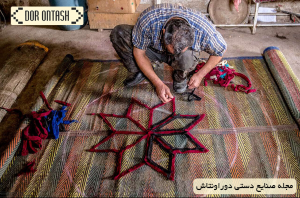
Felt has been used in Asia , especially in Iran, since ancient times as clothes, hats, tents, and underlays , and it has been produced under difficult conditions. The preparation and making of felt in Iran is still done in a traditional way, and the Iranian artist gives it a new spirit with his powerful and artistic hands.
Nemdmal is an industry that is connected with all parts of the body, and nemdmal is full of love for work, along with rhythmic and pleasant movements of hands and feet and singing gentle and rhythmic poems, excessive fatigue caused by continuous work, along with profuse sweating from your tired body. He takes it out and waits for his efforts to be carpeted. A hand tool that shows the natural colorful patterns of beautiful nature with simple and intimate motifs to the viewers to watch the beautiful view of human handiwork that God Almighty has placed at the disposal of the best creatures.
Traditional printing crafts
Printing is dyeing parts of the fabric. Its difference with dyeing is that in dyeing, all parts of the fabric are colored the same. But in printing, it is possible to create a desired design by using one or several colors on a white or painted background. They entered Iran from around the beginning of the 7th century AH and at the time of the invasion of the Mongols. In the past, Isfahan, Shiraz, Borujard, Hamadan, Rasht, Kashan, Nakhjovan, Yazd, Semnan, Gonabad, Najafabad, the villages of Farsan, Ghazbarkhwar, Khorzarq, Barkhar, Lanjan, Sabrah, etc. were among the important centers of calligraphy. In terms of importance, Boroujerdi’s Kalamkar fabrics have been ranked first.
Fabric printing and traditional printing
The production of colored designs and motifs on cloth by basme or mold apparently arose in India in the 4th century before Christ. It is written in Chinese records that printed fabrics were brought to China from India in 140 BC. In Persian, the word chit means printed fabrics. And this word is originally Indian. Roman historian Strabo wrote in the first years after Christ. During his time, printed fabrics were sent from India to Alexandria. The discoveries made in the Egyptian ancient works show that Chit was imported to the markets there until the 14th century. During the Sassanid era, fabric printing was found in Iran and new methods were invented to decorate silk, linen and silk fabrics.
Wicker crafts
wicker crafts The art of weaving threads obtained from the fibers of different plants is called mat weaving. This art is one of the most important sources of income for the residents of coastal areas around the world. Today, the popular art of rattan weaving is used to prepare rattan products , mats, hats, carpets, etc., and rattan handicrafts are among those products that we can clearly see their traces in our lives.
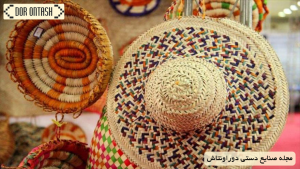
Hashirbafi, which is also known as buriyabafi, is one of the oldest human arts and its history goes back to ancient times. The findings of archaeologists show that the people of Mesopotamia were the first civilization to use mats in their lives. The mats woven by humans were used only as mats at first, but with the passage of many years and the urgent need of nomadic people for the provision of light-weight life supplies, the use of mats for the provision of other essential life supplies also became popular. In today’s era, rattan handicrafts are among the most popular products in urban life and they are used in the production of bags, baskets, underlays, lampshade caps, etc., and their preparation is also possible through the handicrafts online store .
The production method of mat weaving
Early humans used primitive tools to weave mats and prepare mat handicrafts; But this field, just like other aspects of life, was affected by the developments in the world of science and technology throughout history. Today, two different methods of mat weaving are used by mat weaving artists, and we will introduce each of them below:
Weaving mats by hand
Hand weaving is the oldest method of mat weaving, and only a few simple tools are needed to do it. In this method, they use tools such as sickle, knife or scissors to cut the mat and to pierce it, they use tools such as a lid. Mat sewing is also done by hand using very simple tools such as needles.
Leather crafts
Handicrafts of every country is one of the important identifiers in introducing its identity, culture, history and civilization . Considering the position of Iran in the world’s handicrafts , this position can be used to introduce as much Iranian culture and civilization as possible to the world. Iran has a lot of diversity and abundance in handicrafts. # Embroidered leather or Saraji is one of the types of handicrafts in Iran, which has been flourishing in different regions of the country for a long time and has been a supplier of different needs of people. Today , after tanning the leather, the craftsman manufactures all kinds of men’s and women’s leather bags , belts , leather shoes , etc. in this artLeather is the main material for the production of products, and Mashhad leather is one of the most important brands of Iranian leather products .
Khatam Kari
The definition of inlay work in the Persian encyclopedia is “the art of decorating the surface of objects in a mosaic-like manner, with small triangles. The various designs of Khatam have always been in the form of regular geometric shapes. These geometric shapes are patterned by placing small triangles together. Triangles are made from various types of wood, metal and bone. The smaller and more delicate the triangles are, the better the inlay is. In an inlay design, at least three triangles are used to make the smallest geometric unit and for the largest one, a maximum of four hundred triangles are used.”

This art has reached Iran in the present way before the Safavid period and during the conquest of Iran by the Mughal Ilkhan and following the emergence of a direct relationship between Iran and China. Some other researchers also believe that Khatam Kari was founded in Shiraz during the Dilaman period in Iran and reached its peak of prosperity in the Safavid era, because on the one hand, the government supported the artists and on the other hand, it established business relations with far and near countries. The spread of the art of Khatam helped. In Iran, before the advent of Islam, a type of inlaying was popular, and its method of working was that they cut cubes of four millimeters from solid wood and installed and nailed them with various designs on a board, and this method lasted for several centuries. It was also common after Islam. Currently, there is a pulpit inlaid with this method in the Jame Agiq Mosque of Shiraz, which has been built for more than a thousand years.
Woodcarving
Carving is an art that includes engraving and carving on wood. The word carve means carving on wood, and a carver is someone who does carving on wood.
Wood carving in Iran has a very long history and is a relic of the past. Archaeologists and historians have considered the use of wood to build houses in Iran to date back to 4200 BC, which is comparable to the Stone Age and the period when the natives lived in Iran before the migration of the Aryans.most popular iran handicrafts
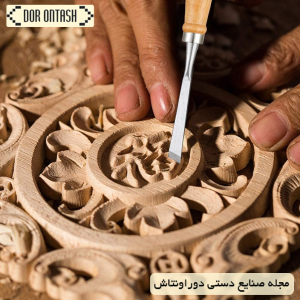
Carving is an art including engraving and carving on wood. This handmade art symbolizes the feeling, perception, thought and initiative of the artists who create the artwork with great taste. Wood carving is a branch of crafts in which patterns are created in relief on the work surface. Wood carving is an art that has its roots in the history of Iran. Inlay work is mostly executed in the form of carving on wood. The wooden ceiling of Hasht Behesht Mansion is one of the examples of Isfahan inlay work that has attracted the attention of many foreign visitors.
Etched
The history of calligraphy printing in Iran is shrouded in mystery. The common methods of traditional printing, which mainly include pen printing, batik and hand printing, have been followed since ancient times in some parts of the world. Tenni Chand, one of Sahib Naran, knows the history of patterning cloth in batik style about two thousand years ago, which started in Indonesia, and even today, many artists are working on batik printing in countless islands in Indonesia. The discovery of the remains of the torso A cloth in Egypt belonging to about 400 BC. which has blue star-shaped motifs and also the discovery of calligraphy molds in India which also dates back to the fourth century BC, all our information and knowledge until today about the history of traditional prints and He is among the writers in other countries of the world.
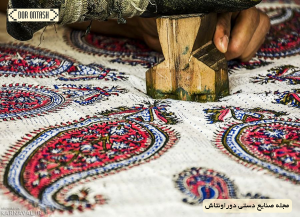
Kobe turquoise
The art of Turquoise Kobi is one of the original Iranian arts that has attracted a lot of fans in the domestic and foreign markets in recent years. This original and beautiful Iranian art was created for the first time about seventy years ago, and since that day until now, turquoise painting is known as a valuable art in Iran.
Marquetry |most popular iran handicrafts
In the meaning of the word, they basically mean anything with streaks, but its meaning in this type of art, especially, is to create beautiful patterns and designs that are formed by cutting and combining colored wood on a background of wood or black polyester. There is another definition of wood carving: wood carving is a kind of work of art in which small pieces of wood, metal, fabric, tile, etc. are beautifully placed next to each other in different shapes.
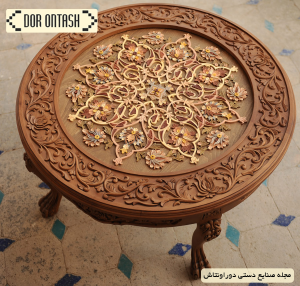
Al-Maraq is creating designs and patterns using small pieces on handicrafts. Maraq is one of the beautiful arts that reached its peak during the Seljuk period. The works left from the 6th century of Hijri show well the subtleties of Seljuk mosaic work.
In the 8th century of Hijri, you can see the most extraordinary paintings by Iranian artists. Iranians were able to create this ancient art with the most beautiful geometric shapes and by applying mathematical science.
Before this period, mosaic tiles were more common, but Iranian artists also used mosaic on smaller and more delicate surfaces. Oriental art is indebted to Iranian artists.
work joke
Juk is one of the arts related to wood, which is created by creating geometric patterns using two to three colors of wood and putting these patterns together with small pieces with different sections of triangles, rectangles, and rhombuses.
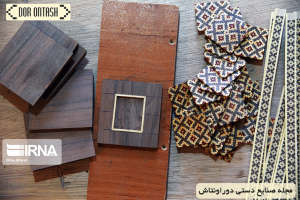
This art is similar to Khatam, with the difference that Jok, like Khatam, is not only used in veneer, but sometimes as a substitute and sometimes as a main member of a special object, for example, as the main coil of a frame, and in The only material used in this art is wood.
The variety of joke designs is so great that any design that can be created with geometric motifs can be used in this art. Jok is used in decorating doors, furniture, around boxes and inlaid frames, inlaying and inlaying.
Polychrome tiles
The seven-color tile became common in different buildings from the end of the Timurid period and the beginning of the Safavid period, which was also called clay tile. At the end of the Timurid and Safavid periods, seven-color tile decorations were gradually replaced by mosaic tiles. The development and prevalence of seven-color tiles can be considered to some extent due to economic and political reasons.
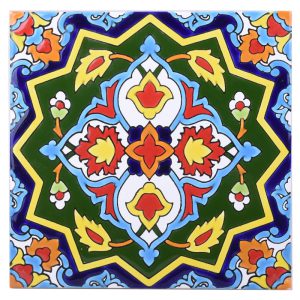
Considering the importance of traditional architecture and traditional tiling, especially in the traditional architecture of mosques and the increasing construction of religious and non-religious buildings in the Safavid period, architects decided to use the seven-color tile decoration method in decorating various buildings.
glazier
Handmade glass is the products that are obtained by shaping melted minerals in the furnace , such as: silica, shards of glass , or a combination of the two, using a special pipe blowing method and the use of hand tools, including pliers, scissors , etc. Named, which includes other finishing and decorative steps such as painting and carving .
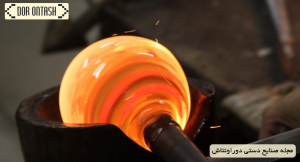 The most famous handicrafts of Iran
The most famous handicrafts of Iran
What are the most famous handicrafts of Iran? As an Iranian, you must know that the variety of handicrafts in our country is very large. Any province you travel to, you will definitely see handicrafts among the souvenirs of each city. That’s why you might have a question, what are the most famous handicrafts of Iran?Almost everywhere in the world, Iran is known as the most important exporter of hand-woven carpets, and this handicraft is one of the most important works of art in Iran, which has a global reputation. In the following article, we will discuss the topic of Iranian carpet in more detail and discuss its popularity. In the continuation of the topic of what is the most famous handicrafts of Iran, you should keep in mind that apart from Iranian carpets, there are some other types of handicrafts that have gained great fame among other countries. In order to be able to check the most popular and famous handicrafts of the country among non-Iranians, we need to have access to accurate statistics. Unfortunately, this statistic cannot be checked because a large volume of handicraft exports is carried out in the form of luggage, which means that the customs fee is not considered for it. This luggage export happens both by Iranians and by foreign tourists. Based on a study in 2016, it was estimated that about 240 million dollars worth of handicrafts left the borders of Iran in the form of suitcases, and another 240 million dollars were officially transferred and sold outside of Iran by businessmen. So, with these simple calculations, you will realize that handicrafts play an important role in importing currency to the country. On the other hand, the handicrafts of each region represent the cultural identity of its people, and by expanding people’s knowledge of the country’s handicrafts, we introduce our culture to others and at the same time help its survival.
- carpet weaving
- Carpet weaving
- Mat weaving
- Enamels
- turquoise caloric
Handicrafts of Iranian cities
Handicrafts of Iranian cities are so diverse that one article is not enough to introduce all of them and it does not fit into one article. However, we intend to briefly but effectively examine some things about the handicrafts of Iranian cities so that the importance of these industries can be determined more than before. It is true that currently the handicrafts of Iranian cities It has been introduced to a great extent and a large number of them have been registered as national heritage, but note that unfortunately a number of handicrafts have been forgotten and only their names remain. For example, in remote villages, the creation of these handicrafts is known as the job of many people, and with the advancement of technology, these jobs have been out of order or with the death of the masters, they have been completely eliminated. However, we still know a large number of Iranian handicrafts that have continued to survive and are learned and created by the young generation.
Research on Iranian handicrafts
Research on Iranian handicrafts This makes it clear to us that Iran has a very rich culture and people have been interested in art education in all ages and have passed art to their next generations for many years. Also, by researching Iran’s handicrafts, we find that the type of handicrafts in each region of the country depends on many factors, and among these factors we can mention natural resources. Also, the original handicrafts, which are made with the least intervention of machines, are valuable and are kept as exquisite decorative items in Iranian and foreign homes. Of course, we must point out here that the connection of handicrafts with the lives of Iranian people is not interrupted and is not limited to decorative and exquisite items, and many items of handicrafts are used by Iranians as practical and important items in everyday life. You live in any city of Iran, you have one or more Iranian carpets at home, maybe these carpets are not handwoven, but the Iranian map is definitely one of the inseparable items of the Iranian home. Now, depending on what city you live in, related crafts can be seen around you that may be decorative or functional.
What are the best handicrafts of Iran?
The identity of any country can be found in the culture and history of that ancient civilization, and this identity tells a part of an ancient story of the connections between the art and civilization of the people of that region. Iran, having a rich and deep civilization, It is considered one of the founders of cultural and historical civilization among all the countries of the world. This manifestation of Iranian civilization can be seen in the art left by Iranian ancestors in historical works such as tombs, mosques, palaces and many others of this category. of the works found, but in these historical works, works of art play the main role.
Works of art , by being used in various structures of society, have played their role in conveying their mission, as a part of Iran’s cultural identity by creating different local and national layers in cultural works from the past to the present.
But among the works of art despite the existence of different cultures throughout Iran, we see different works, one of the most luxurious of these works of art is the art of handicrafts, which brings a manifestation of ethnic and national culture to the fore.
Click to read a comprehensive article about Iran’s best handicrafts .
The most famous handicrafts of Iran
After India and China, Iran is the third largest producer of handicrafts in the world. Iran’s handicrafts include 155 fields, 18 groups and 140 subgroups, but carpet, which is considered one of the oldest Iranian arts, is not considered among the subgroups of the handicrafts organization of this country. Also, Iran is the first country in the world to register villages and global cities. According to the research, more than one million people work in handicrafts, many of them are working in remote villages and cities.
Considering that Iran has a civilization of 5 thousand years and has a rich culture and tradition, it is impossible not to see a great variety of arts and crafts. In general, in Iran, we see handicrafts in all climatic and geographical regions.
Among these arts, we can
- pottery
- Needlework
- Carpet weaving
- Mat weaving
- Cupobuffy
- Masonry
- Maraq
- Baluchi embroidery
- Weaving
photos of most popular iran handicrafts
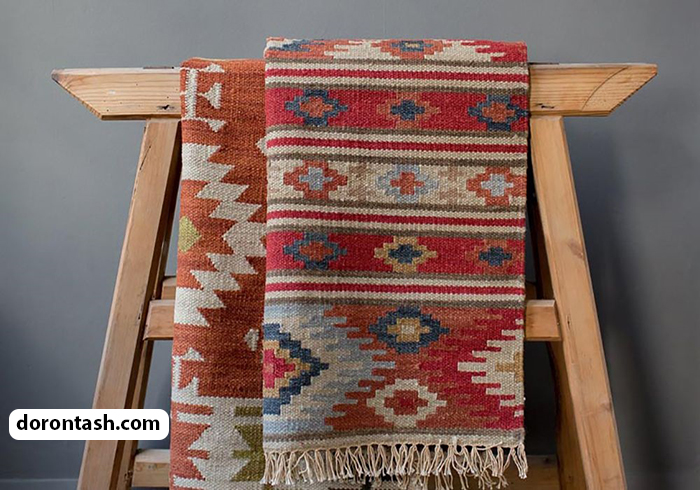
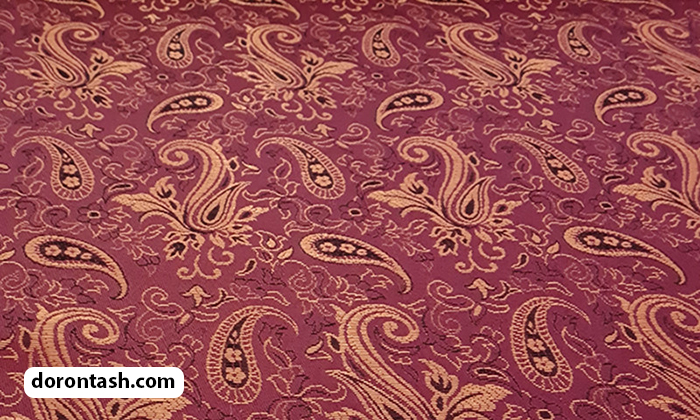
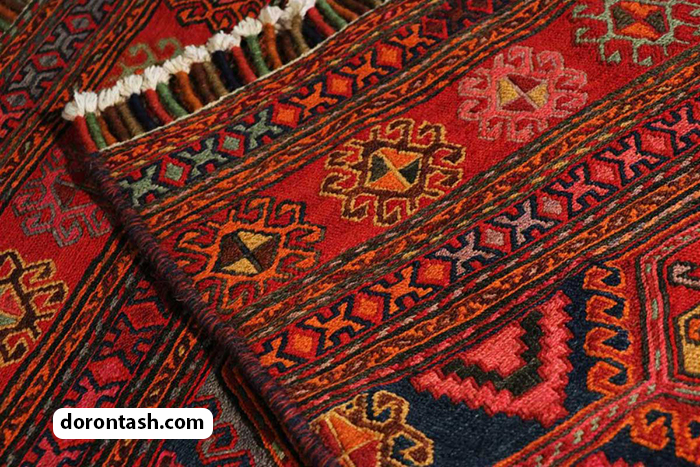
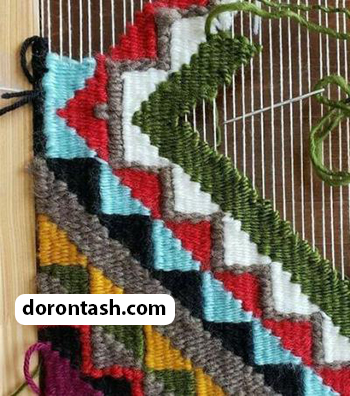
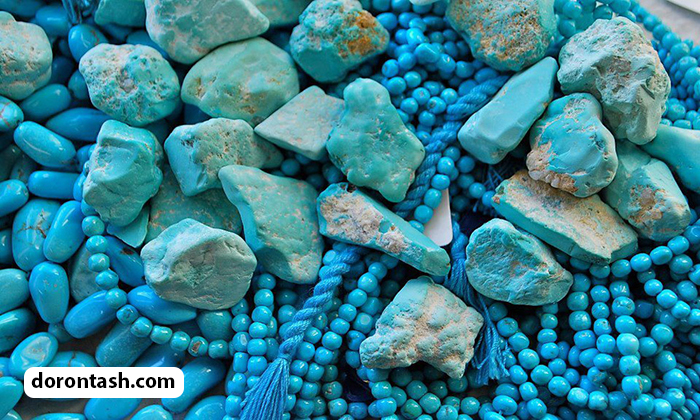
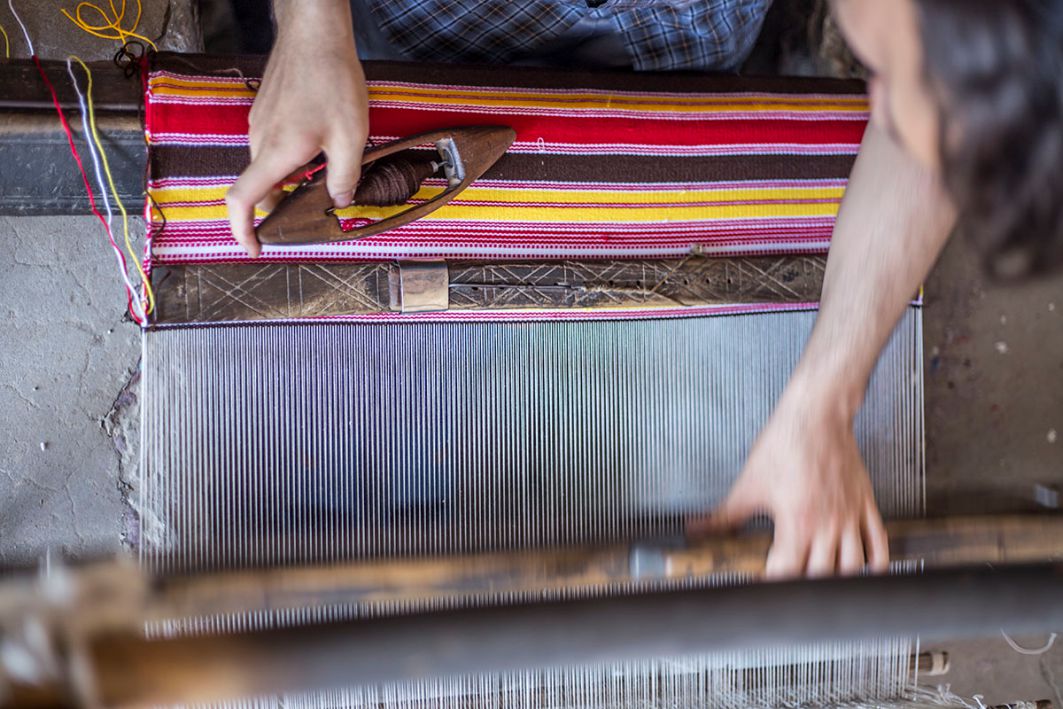
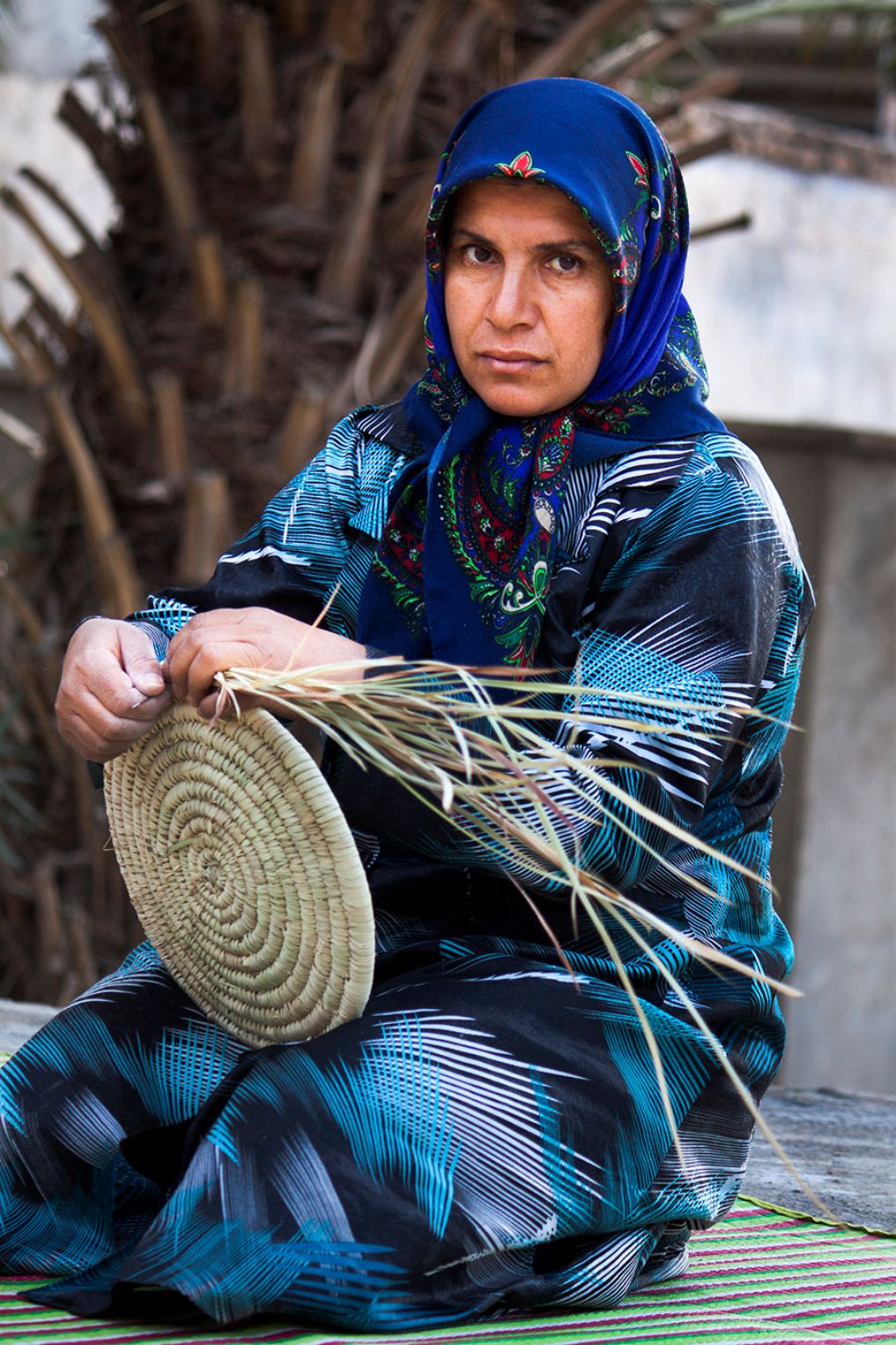
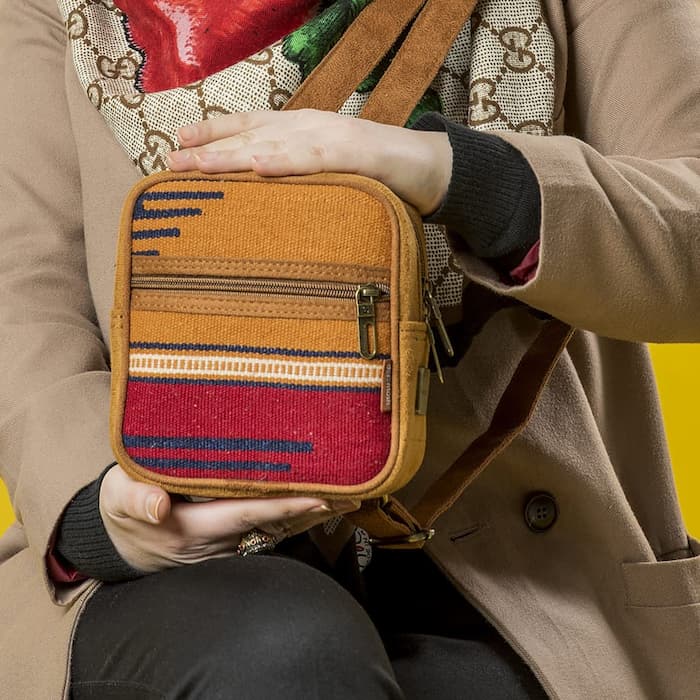

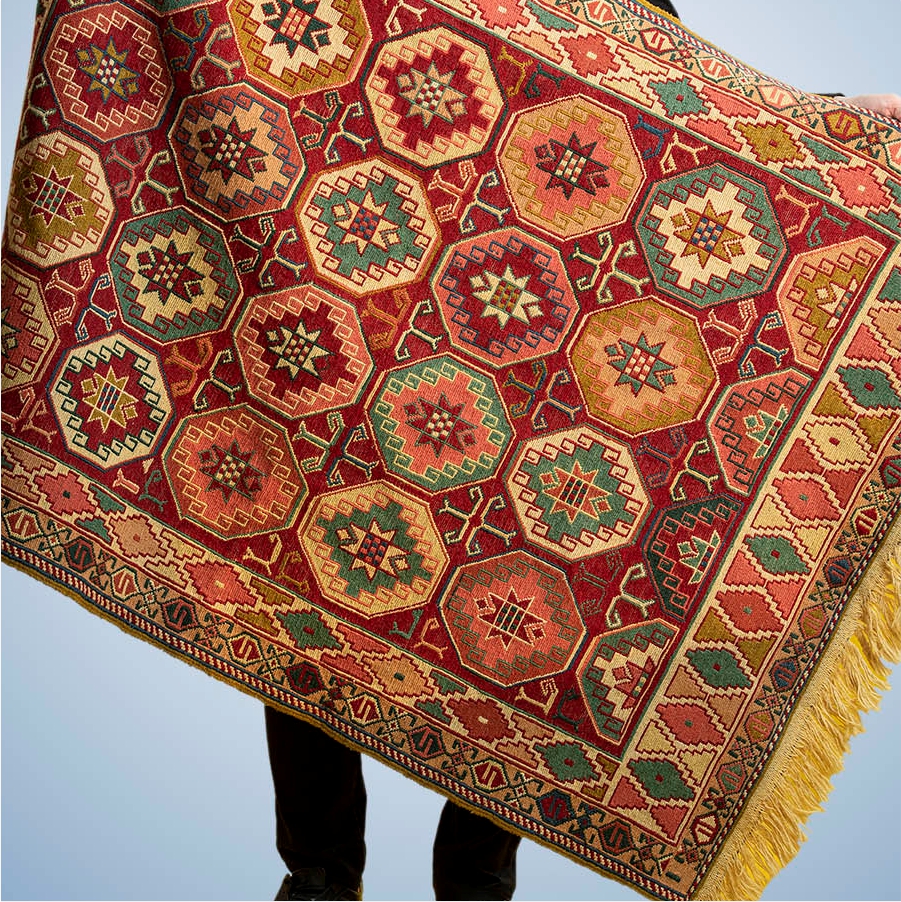
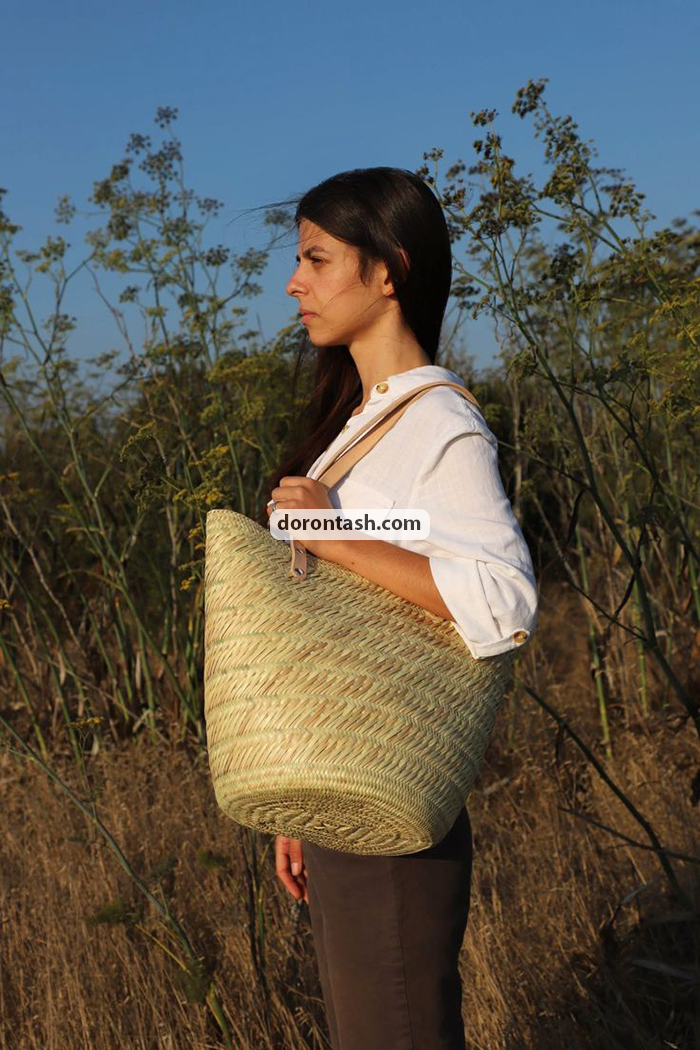

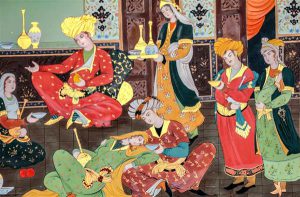
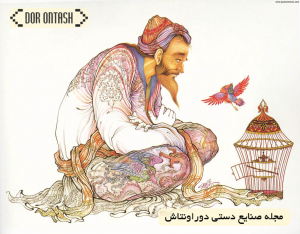
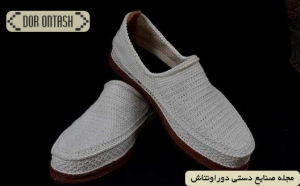
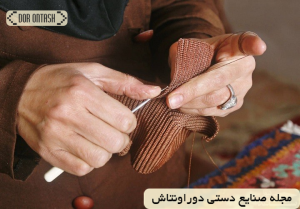
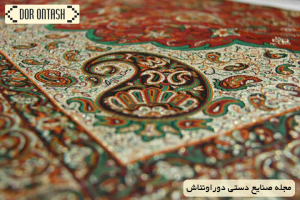
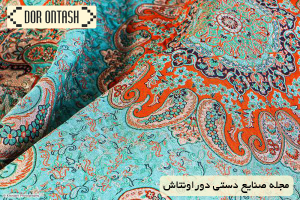
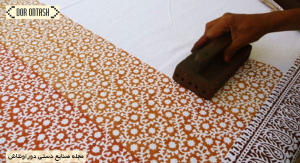
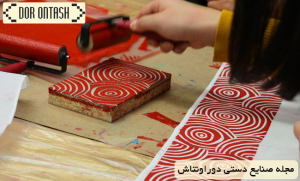
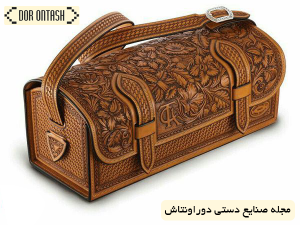
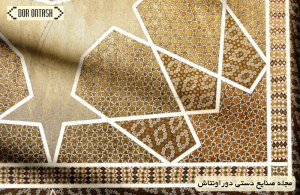

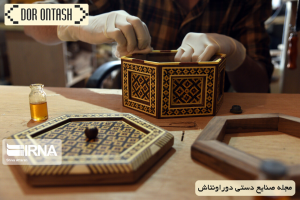
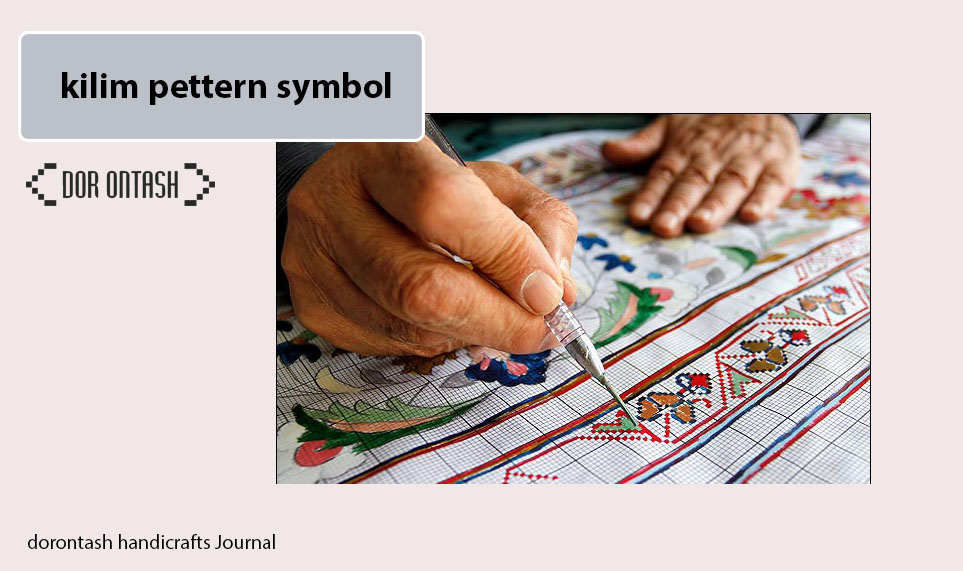
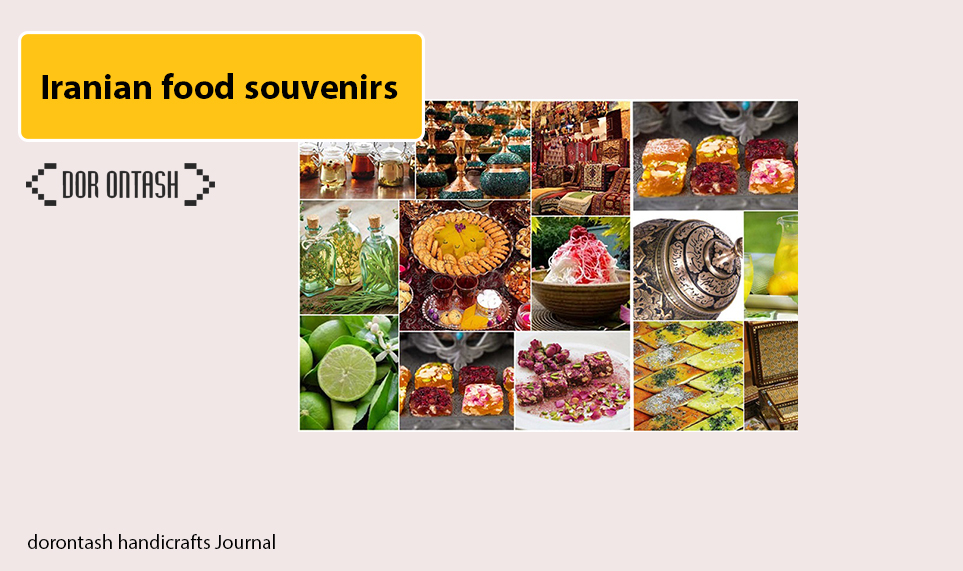
2 Comments. Leave new
مطلب کامل و جامعی بود ممنون عالی بود
صنایع دستی ایران همه عالی هستن . چقدر کامل به همه آنها اشاره کردید